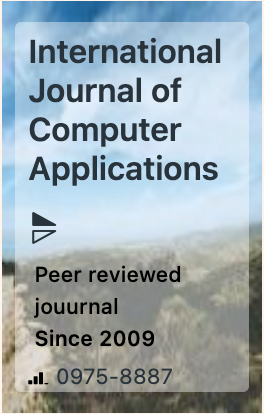The week's pick
Random Articles
Reseach Article
Using Naive Models to Improve US Dollar Exchange Rate Trend Prediction
| International Journal of Computer Applications |
| Foundation of Computer Science (FCS), NY, USA |
| Volume 186 - Number 79 |
| Year of Publication: 2025 |
| Authors: Elia Yathie Matsumoto, Emilio Del-Moral-Hernandez, Claudia Emiko Yoshinaga, Afonso de Campos Pinto |
 10.5120/ijca2025924709
10.5120/ijca2025924709
|
Elia Yathie Matsumoto, Emilio Del-Moral-Hernandez, Claudia Emiko Yoshinaga, Afonso de Campos Pinto . Using Naive Models to Improve US Dollar Exchange Rate Trend Prediction. International Journal of Computer Applications. 186, 79 ( Apr 2025), 68-75. DOI=10.5120/ijca2025924709
Abstract
This paper extends our previous research, which proposed a methodology based on the following hypothesis: dealing with the problem of predicting the next-day USD/BRL exchange rate daily trend, the existence of calendar effects allows us to improve trained voting-based ensemble models without model retraining. In the present work, we propose adding naïve models to the originally proposed methodology because naïve models would also potentially benefit from the calendar effect becoming a benchmark to consider. The experiments confirmed that naïve models are not just challenging benchmarks but also models that can be included in the process to improve existing voting-ensemble models. On average, adding the naïve models to the original solution generated an increase higher than 100% in the value of the primary metric adopted for performance measurement. Constantly overwhelmed by more complex solutions, we can take these outcomes as a reminder not to neglect simplicity.
References
- Abir, S.I. et al. 2024. Use of AI-Powered Precision in Machine Learning Models for Real-Time Currency Exchange Rate Forecasting in BRICS Economies. Journal of Economics, Finance and Accounting Studies. 6, 6 (2024), 66–83.
- Domingos, P. 1999. The Role of Occam’s Razor in Knowledge Discovery. Data Mining and Knowledge Discovery. 3, 4 (1999), 409–425. DOI: https://doi.org/10.1023/A:1009868929893.
- Kailash Thiyagarajan 2025. Enhancing E-Commerce Product Page Recommendations using Large Language Models. International Journal of Computer Applications. 186, 68 (Feb. 2025), 49–54.
- López de Prado, M. 2018. Advances in financial machine learning. John Wiley & Sons.
- Matsumoto, E.Y. et al. 2022. Forecasting US Dollar Exchange Rate Movement with Computational Models and Human Behavior. Expert Systems with Applications. 194, (2022), 116521. DOI: https://doi.org/10.1016/j.eswa.2022.116521.
- Meese, R.A. and Rogoff, K. 1983. Empirical exchange rate models of the Seventies: do they fit out of sample? Journal of International Economics. 14, (1983), 3–24.
- Muhammad, A. et al. 2021. Forecasting Chinese Yuan/USD Via Combination Techniques During COVID-19. The Journal of Asian Finance, Economics and Business. 8, 5 (2021), 221–229. DOI: https://doi.org/10.13106/JAFEB.2021.VOL8.NO5.0221.
- Shobayo, O. et al. 2025. A Comparative Analysis of Machine Learning and Deep Learning Techniques for Accurate Market Price Forecasting. Analytics 2025, Vol. 4, Page 5. 4, 1 (Feb. 2025), 5. DOI: https://doi.org/10.3390/ANALYTICS4010005.
- Sicsú, A.L. et al. 2023. Técnicas de machine learning. Editora Blucher.
- Xie, Q. et al. 2024. FinBen: A Holistic Financial Benchmark for Large Language Models. Advances in Neural Information Processing Systems (2024), 95716–95743.
- Zhang, Y. and Hamori, S. 2020. The Predictability of the Exchange Rate When Combining Machine Learning and Fundamental Models. Journal of Risk and Financial Management. 13, 3 (2020), 48. DOI: https://doi.org/10.3390/JRFM13030048.
Index Terms
Keywords

